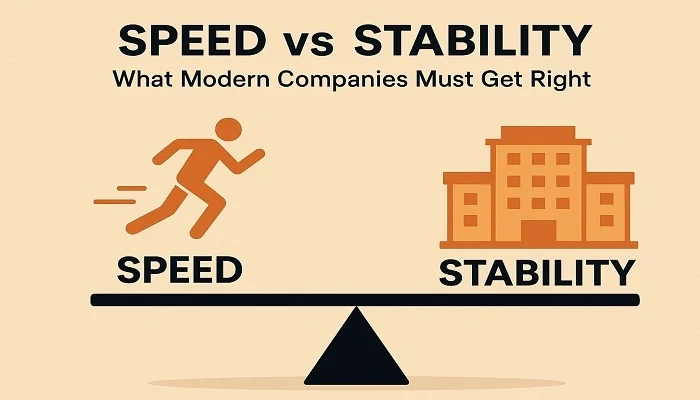Speed gets you noticed. Stability keeps you standing.
That’s the paradox modern companies wrestle with every day. You want to ship fast, respond quickly, and launch before someone else does. But if your product breaks, your users won’t care how quickly it got there – they’ll just leave. And when your infrastructure can not keep up with your pace, then speed is not your strength but a liability.
It is not merely a technical dilemma. It is a tactical one. It is not a question of two features to pick and choose, but rather a question of business imperatives to navigate between. Go too fast out of control, and quality falls between the cracks. Over-engineer for stability, and you might miss your window.
So where’s the sweet spot?
This article explores how high-performing companies approach that tension. You’ll get a closer look at what happens when speed tramples process, or when process smothers progress. More importantly, we’ll look at how to build systems, teams, and habits that let both forces coexist. Whether you’re scaling a startup or modernizing enterprise workflows, understanding how to balance agility with resilience is the difference between momentum and meltdown.
Let’s talk about what that balance really looks like and how you can get closer to it.
The Case for Speed: Agility as a Competitive Advantage
Speed isn’t just about being fast. It’s about being first to learn, first to solve, and sometimes, first to fail and recover.
In tech-driven markets, time-to-market can determine whether your product leads or lags. Customers don’t wait. Neither does innovation. Speed gives companies the chance to respond quickly to feedback, iterate on features, and ship updates that reflect real user needs. When velocity is paired with feedback loops, speed becomes a learning engine, not just a race.
Startups have mastered this mindset. They thrive by doing what larger organizations struggle with: moving fast without overanalyzing. That’s how challenger banks chipped away at incumbents. How Shopify scaled past legacy commerce platforms. They didn’t need to be perfect on day one – they needed to get in the game early and evolve. But here’s where it gets risky.
Move too fast, and the foundation starts to buckle. When teams are constantly racing against the clock, burnout isn’t far behind. Shortcuts taken under pressure turn into long-term technical debt. Even worse, users notice bugs slip through, reliability suffers, and trust fades before it has a chance to take root. Velocity without guardrails doesn’t scale – it frays.
This is where testing earns its keep. Fast-moving companies can’t afford to treat quality as an afterthought. That’s why many teams bring in seasoned support like software QA services DeviQA, to make sure their pace doesn’t come at the cost of product stability.
Agility gives you the edge. But if you don’t build wisely, that edge cuts both ways.
The Case for Stability: Building for the Long Term
Speed may earn you some attention, but stability pays the bills. When your product crashes at the time of maximum use, no one will be interested in how quickly you delivered it.
These are not glamorous things, reliability, security, and operational discipline, but that is what can lead to real growth. They establish the environment in which users remain, trust grows, and business grows without falling on its own weight. In particular, in such industries as finance or health, one mistake may cause legal risks, compliance consequences, or backlash.
Systems are the foundation of stability. Teams are kept in line by governance. QA eliminates the occurrence of defects for the customers. Infrastructure guarantees performance and uptime. They are a silent engine underneath the product experience together.
The companies, such as Stripe and Atlassian, did not expand on glamorous launches. They earned loyalty by being steady, predictable, and safe to build on. Their platforms are trusted precisely because they don’t go down, and they don’t surprise users in the wrong way.
But there’s a catch. You can overcorrect. Layer too many processes and approvals, and momentum grinds to a halt. Projects stretch out. Opportunities pass you by. Large enterprises often fall into this trap, prioritizing perfect governance at the cost of market responsiveness.
That’s why high-performing teams strike a balance. They make long-term bets on testing, documentation, and failover systems, especially when the stakes are high. A healthcare software development company, for example, can’t afford to treat QA as a box-checking exercise. Their code affects lives, not just user flows. Here, stability isn’t just wise – it’s non-negotiable.
Done right, stability isn’t slowness. It’s speed that doesn’t break when you need it most.
Conclusion
Striking the right balance between speed and stability isn’t about compromise – it’s about discipline. The most resilient companies don’t sacrifice reliability to move fast, nor do they stall innovation to stay safe. They build frameworks where both can thrive. They know when to push, when to pause, and how to make those calls consistently.
That means more than just agile sprints and uptime SLAs. It means phased rollouts to catch issues early. It means embedding continuous integration and testing into your pipelines so quality doesn’t get left behind. It means aligning your teams on what matters most, shipping fast when it’s low-risk, and slowing down when it counts. It means saying no to features that aren’t ready and yes to systems that help you scale without cracks. Ultimately, speed gets you to the market, but stability keeps you in it.
So, if you’re trying to figure out which to prioritize, maybe you’re asking the wrong question. The real challenge isn’t picking a side. It’s designing processes, teams, and infrastructure that let you move fast without breaking the very trust you’ve worked so hard to earn.
Pedrovazpaulo Executive Coaching: Unlocking Potential with Its Power









Comments